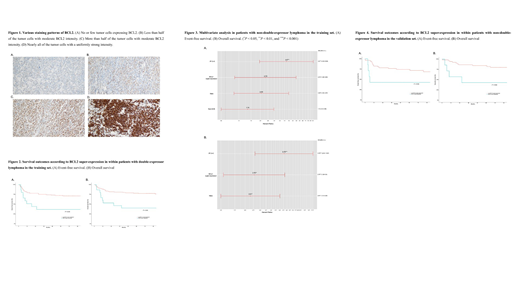Introduction
Diffuse large B-cell lymphoma (DLBCL) is a heterogeneous disease that can be characterized by distinct pathologic subtypes, morphologic variants, and gene expression profiles. Co-expression of MYC and BCL2 proteins by immunohistochemistry (IHC) is considered to be a poor prognostic factor and is defined as double-expressor lymphoma (DEL). However, only few studies have sought to establish definite criteria for the evaluation of BCL2 expression, and currently, only the proportion of BCL2 positive tumor cells are considered in determining the BCL2 positivity. The staining patterns of BCL2 are very diverse (Figure 1A-D). Recently, the importance of the intensity of BCL2 expression has been recognized by several studies, and patients with BCL2 expression with uniformly strong intensity were associated with poor survival outcome.
We aimed to evaluate the prognostic value of BCL2 expression by IHC, incorporating both the staining intensity and proportion, in patients with de novo DLBCL who received rituximab, cyclophosphamide, doxorubicin, vincristine, and prednisone (R-CHOP) as first-line treatment. Its prognostic value was assessed separately in patients with DEL and non-DEL.
Methods
We retrospectively collected formalin-fixed, paraffin-embedded (FFPE) diagnostic biopsies from 187 patients with de novo DLBCL between January 2006 and December 2012 at our institute. All patients were treated with R-CHOP as first-line treatment. A separate validation set included 59 patients with non-double expressor de novo DLBCL who received first-line R-CHOP at another tertiary hospital in South Korea.
DEL was defined as MYC expression in ≥ 40% tumor cells and concurrent BCL2 expression in ≥ 50% tumor cells by IHCs. BCL2 super-expressor was defined as BCL2 expression in nearly all of the tumor cells with a uniformly strong intensity, which is higher than that of adjacent reactive T-cells (Figure 1D). Cell of origin (COO) was determined according to the Hans classification using IHC.
Results
The median age was 59 years (range, 48-68), 103 patients (55.1%) were male and 57 (30.5%) had DEL in the training set. Twenty-three patients (12.3%) were classified as BCL2 super-expressor. There was no significant difference in age, sex, Ann arbor stage, International Prognostic Index (IPI), and COO between BCL2 super-expressors (n = 23) and non-BCL2 super-expressors (n = 164). With a median follow up duration of 102.2 months (95% CI, 94.2-111.2), BCL2 super-expressor had significantly worse OS than non-BCL2 super-expressor with a 5-year overall survival (OS) rate of 47.8% (95% CI, 31.2-73.3) and 74.3% (95% CI, 67.9-81.3), respectively (P = 0.01).
The prognostic impact of BCL2 super-expressor was then separately evaluated within DELs (n = 57) and non-DELs (n = 130). There was no significant difference in the event-free survival (EFS) and OS rates between BCL2 super-expressors and non-BCL2 super-expressors (5-year EFS: 62.5 vs. 50.6%, P = 0.65; 5-year OS: 62.5 vs. 65.3%, P = 0.99) within patients with DELs. In patients with non-DELs, BCL2 super-expressors had significantly worse outcomes (5-year EFS: 36.7 vs. 72.3%, P = 0.005; 5-year OS: 40.0 vs. 78.2%, P = 0.002) (Figure 2A, B).
Univariate and multivariate analyses of the potential prognostic factors for EFS and OS were performed in non-DEL patients. In the univariate analysis, male, non-GCB group, high IPI, and BCL2 super-expressor showed potential association (P < 0.2) with both poor EFS and OS. In the multivariate analysis, BCL2 super-expression was an independent prognostic factor for worse EFS (vs. non-BCL2 super-expressor; HR, 2.72; 95% CI, 1.26-5.86, P = 0.011) and OS (vs. BCL2 non-super-expressor; HR, 2.76; 95% CI, 1.29-5.9, P = 0.009) (Figure 3A, B). In addition, male and high IPI (3-5 vs. 0-2) was also independently associated with both worse EFS and OS.
The adverse impact of BLC2 super-expressor in non-DELs was further validated in the independent validation set. BCL2 super-expressor demonstrated a significantly worse EFS and OS than non-BCL2 super-expressor (5-year EFS: 42.9 vs. 74.4%, P = 0.034; 5-year OS: 42.9 vs. 84.2%, P = 0.022) (Figure 4A, B).
Conclusion
BCL2 super-expression may define a distinct subgroup of DLBCL with poor prognosis from double expressors, which warrants further validation in large cohorts.
No relevant conflicts of interest to declare.
Author notes
Asterisk with author names denotes non-ASH members.


This feature is available to Subscribers Only
Sign In or Create an Account Close Modal